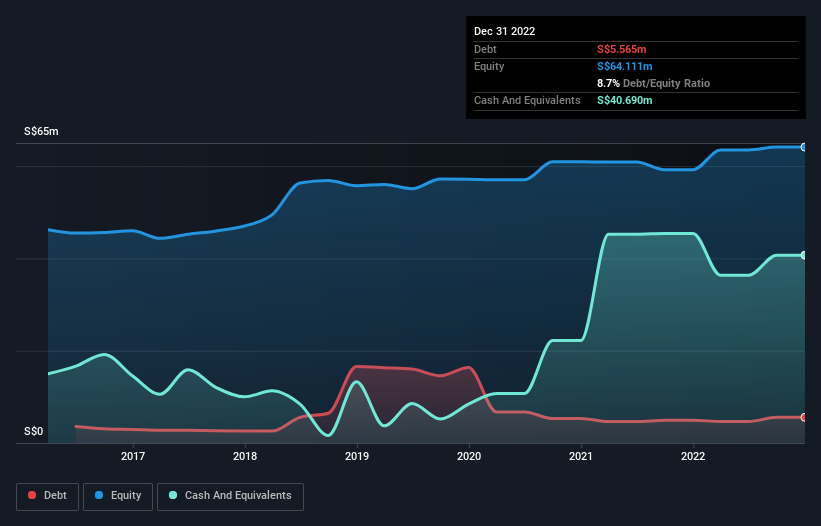Grand Banks Yachts (SGX:G50) Has A Pretty Healthy Balance Sheet

Warren Buffett famously said, 'Volatility is far from synonymous with risk.' It's only natural to consider a company's balance sheet when you examine how risky it is, since debt is often involved when a business collapses. We note that Grand Banks Yachts Limited (SGX:G50) does have debt on its balance sheet. But the real question is whether this debt is making the company risky.
When Is Debt Dangerous?
Debt is a tool to help businesses grow, but if a business is incapable of paying off its lenders, then it exists at their mercy. If things get really bad, the lenders can take control of the business. While that is not too common, we often do see indebted companies permanently diluting shareholders because lenders force them to raise capital at a distressed price. By replacing dilution, though, debt can be an extremely good tool for businesses that need capital to invest in growth at high rates of return. When we examine debt levels, we first consider both cash and debt levels, together.
View our latest analysis for Grand Banks Yachts
How Much Debt Does Grand Banks Yachts Carry?
As you can see below, at the end of December 2022, Grand Banks Yachts had S$5.57m of debt, up from S$4.93m a year ago. Click the image for more detail. But on the other hand it also has S$40.7m in cash, leading to a S$35.1m net cash position.

How Healthy Is Grand Banks Yachts' Balance Sheet?
We can see from the most recent balance sheet that Grand Banks Yachts had liabilities of S$47.2m falling due within a year, and liabilities of S$4.12m due beyond that. On the other hand, it had cash of S$40.7m and S$14.0m worth of receivables due within a year. So it actually has S$3.36m more liquid assets than total liabilities.
This surplus suggests that Grand Banks Yachts has a conservative balance sheet, and could probably eliminate its debt without much difficulty. Succinctly put, Grand Banks Yachts boasts net cash, so it's fair to say it does not have a heavy debt load!
Although Grand Banks Yachts made a loss at the EBIT level, last year, it was also good to see that it generated S$8.2m in EBIT over the last twelve months. When analysing debt levels, the balance sheet is the obvious place to start. But you can't view debt in total isolation; since Grand Banks Yachts will need earnings to service that debt. So if you're keen to discover more about its earnings, it might be worth checking out this graph of its long term earnings trend.
Finally, a business needs free cash flow to pay off debt; accounting profits just don't cut it. Grand Banks Yachts may have net cash on the balance sheet, but it is still interesting to look at how well the business converts its earnings before interest and tax (EBIT) to free cash flow, because that will influence both its need for, and its capacity to manage debt. Considering the last year, Grand Banks Yachts actually recorded a cash outflow, overall. Debt is usually more expensive, and almost always more risky in the hands of a company with negative free cash flow. Shareholders ought to hope for an improvement.
Summing Up
While it is always sensible to investigate a company's debt, in this case Grand Banks Yachts has S$35.1m in net cash and a decent-looking balance sheet. So we are not troubled with Grand Banks Yachts's debt use. There's no doubt that we learn most about debt from the balance sheet. But ultimately, every company can contain risks that exist outside of the balance sheet. For example Grand Banks Yachts has 3 warning signs (and 2 which are concerning) we think you should know about.
At the end of the day, it's often better to focus on companies that are free from net debt. You can access our special list of such companies (all with a track record of profit growth). It's free.
New: Manage All Your Stock Portfolios in One Place
We've created the ultimate portfolio companion for stock investors, and it's free.
• Connect an unlimited number of Portfolios and see your total in one currency
• Be alerted to new Warning Signs or Risks via email or mobile
• Track the Fair Value of your stocks
Have feedback on this article? Concerned about the content? Get in touch with us directly. Alternatively, email editorial-team (at) simplywallst.com.
This article by Simply Wall St is general in nature. We provide commentary based on historical data and analyst forecasts only using an unbiased methodology and our articles are not intended to be financial advice. It does not constitute a recommendation to buy or sell any stock, and does not take account of your objectives, or your financial situation. We aim to bring you long-term focused analysis driven by fundamental data. Note that our analysis may not factor in the latest price-sensitive company announcements or qualitative material. Simply Wall St has no position in any stocks mentioned.
About SGX:G50
Grand Banks Yachts
Manufactures and sells luxury recreational motor yachts in the United States, Australia, Europe, and Asia.
Flawless balance sheet with solid track record.
Market Insights
Community Narratives



